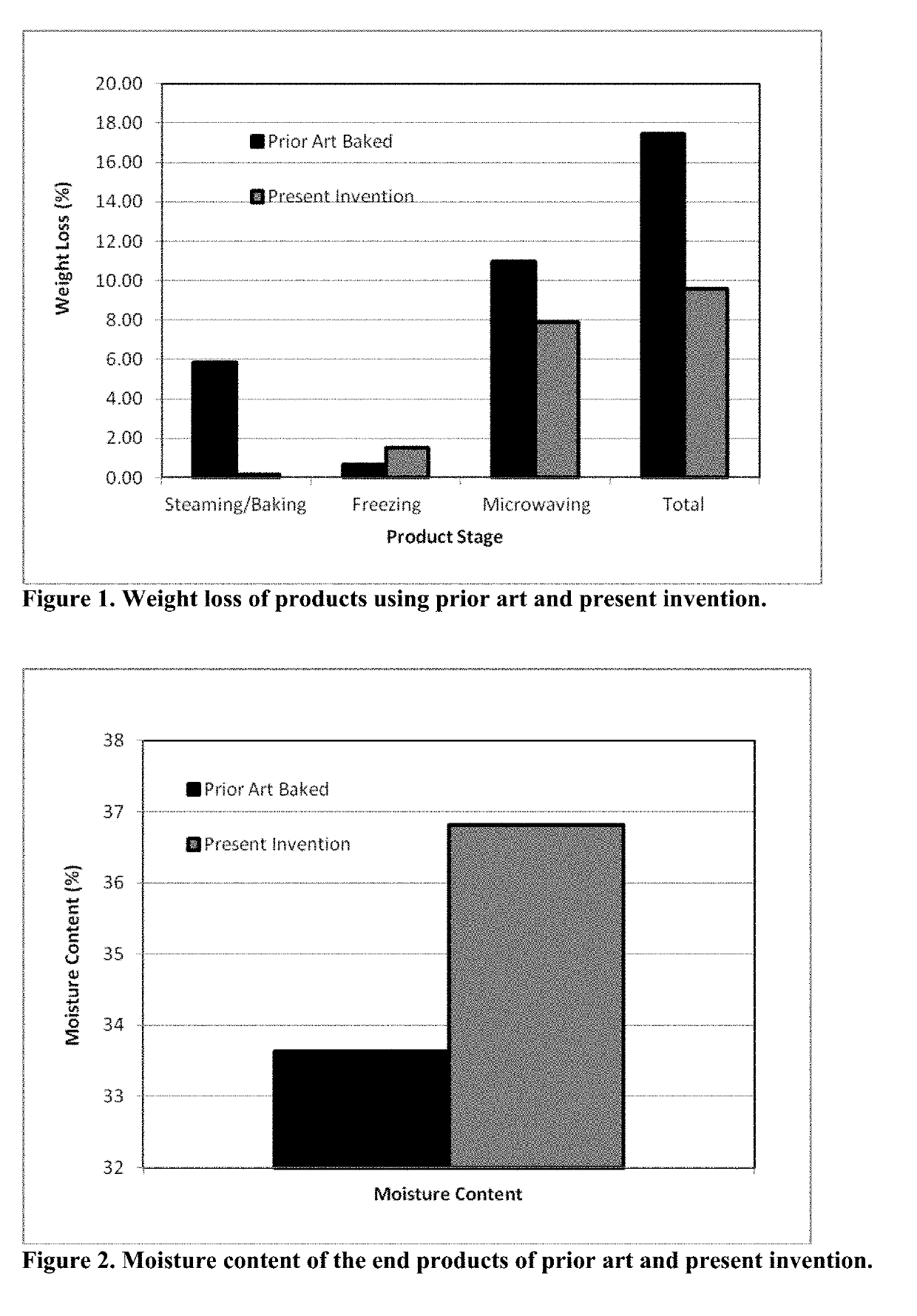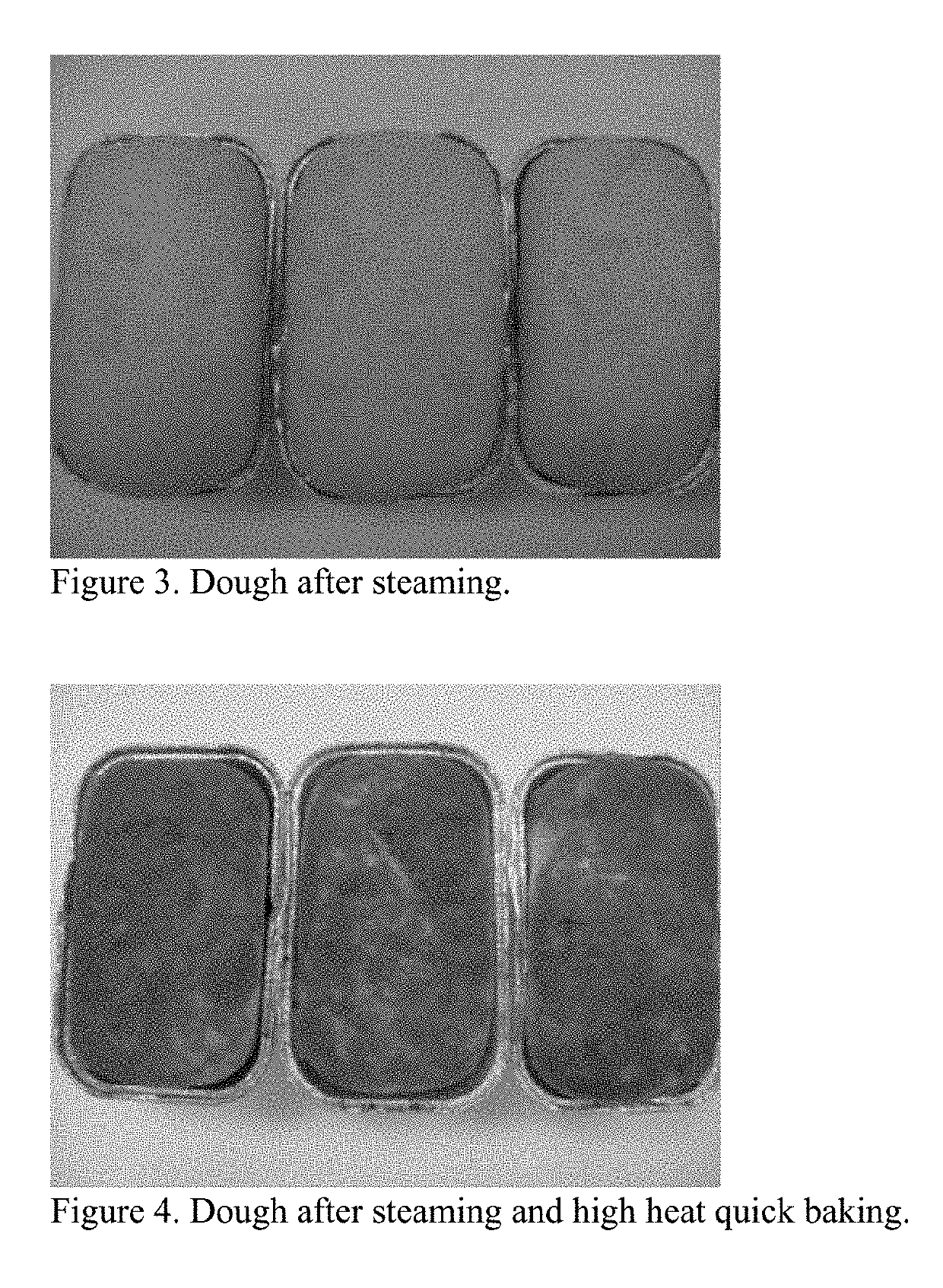Microwaveable Frozen Breads and Method of Making The Same
- Summary
- Abstract
- Description
- Claims
- Application Information
AI Technical Summary
Benefits of technology
Problems solved by technology
Method used
Image
Examples
example 1
[0025]A mini bread is prepared according to an embodiment of present invention, and moisture loss, moisture content, and product hardness were compared to product of a prior art. A mini pan bread formula is used in the test and is given in Table 1. Bread of the prior art and present invention are all made from the same formula. Bread of the prior art is baked after proofing whereas bread of the present invention is steamed followed by a quick high heat short time baking.
[0026]During the preparation of dough, ingredients were weighed according to Table 1. All dry ingredients, including flour, yeast, salt, sugar whey and non fat dry milk were added to a Kitchen Aid Mixer, malt syrup and shortening was added, and ascorbic acid was added with a small amount of water. The content was mixed for 1 min at low (speed 1). Water was then added to the dry blend in mixing bowl and the content was mixed for approximately 2 min at low speed 2 and 5 min at high speed 4. After mixing, dough temperat...
example 2
[0029]A sandwich bun was prepared according to an embodiment of the present invention. The formula and procedures for making the dough are the same as those described in Example 1. After mixing, the dough was divided to 100 g dough pieces, rounded by hand to dough balls, allowed to sit on individual baking papers, and proofed for 2 h at 95° F. and 70% humidity. Control products were prepared by baking at 400° F. for 16 min, whereas products of the present invention were steamed for 6 min and then quick baked at 600° F. for 1 min. The steaming adds moisture to the product and the high heat quick bake procedure develops a golden brown crust without excessive moisture loss. All samples are stored frozen at −10° F. When ready to use, the products were taken directly from freezer and microwaved with a pouch type susceptor for 1.5 min for the buns in a 1000W microwave oven. Weight loss and sensory scores are given in Table 3.
[0030]As can be seen from Table 3, the total loss of the prior a...
example 3
[0032]Dough formulation of a hearth bread was made according to an embodiment of the present invention, and bread after microwave cooking was evaluated for moisture loss, hardness and toughness.
[0033]A sponge dough was mixed using formulations of Table 4. All ingredients were added into a Kitchen Aid mixer and mixed for 2 min. The dough batter was covered and allowed to ferment at room temperature (70° F.) for 2 h. The sponge was then combined with additional ingredients of flour, year and salt, and used to make the dough. The dough was mixed for 1 min at low speed 2 and then mixed for 7 min at high speed 4. The dough was then divided to 250 g dough loaf and rounded to a hearth bread on a parchment paper. It was then transferred into a proofer and proofed at 86° F. and 70% humidity for about 2 hours. For control product following the prior art, the product was baked in a conventional oven at 400° F. for 26 min. The products were then frozen and stored at −10° F. until use. For the p...
PUM
 Login to View More
Login to View More Abstract
Description
Claims
Application Information
 Login to View More
Login to View More - Generate Ideas
- Intellectual Property
- Life Sciences
- Materials
- Tech Scout
- Unparalleled Data Quality
- Higher Quality Content
- 60% Fewer Hallucinations
Browse by: Latest US Patents, China's latest patents, Technical Efficacy Thesaurus, Application Domain, Technology Topic, Popular Technical Reports.
© 2025 PatSnap. All rights reserved.Legal|Privacy policy|Modern Slavery Act Transparency Statement|Sitemap|About US| Contact US: help@patsnap.com


